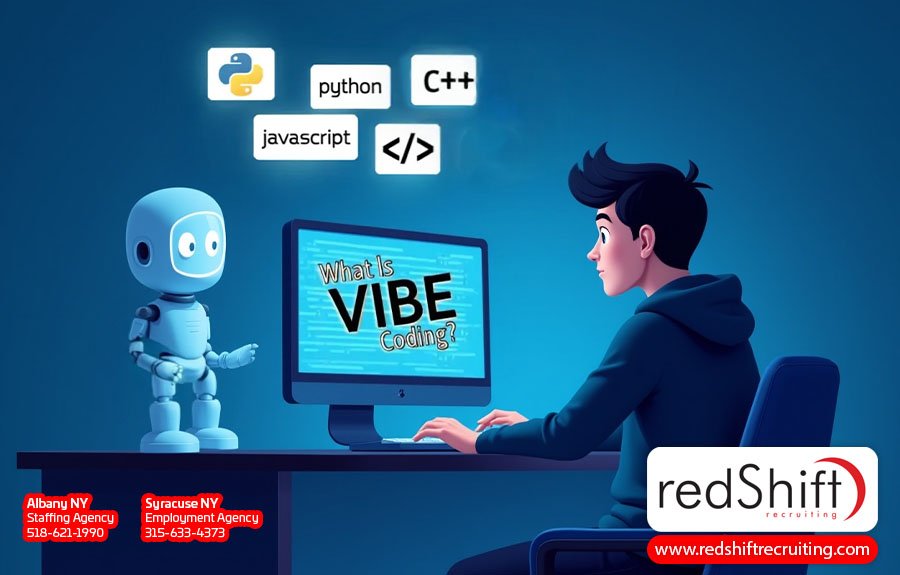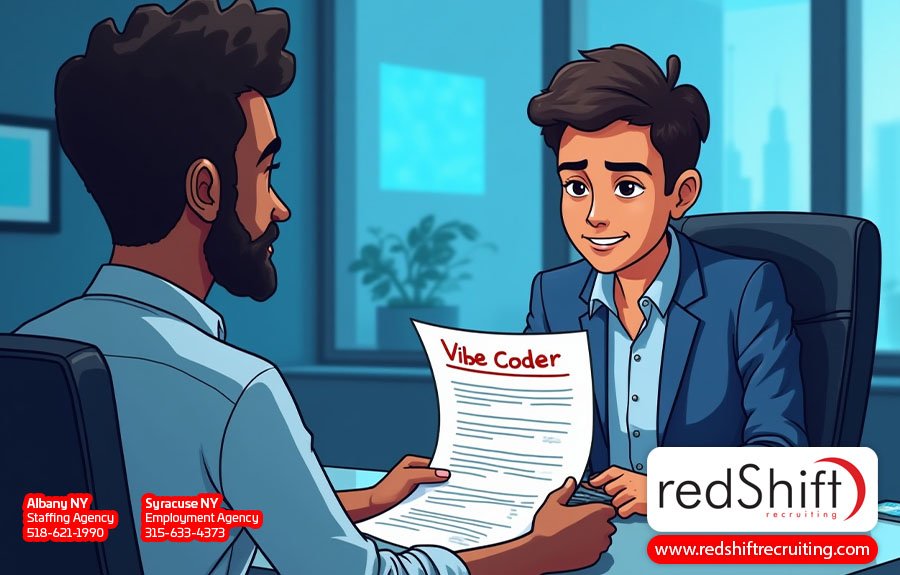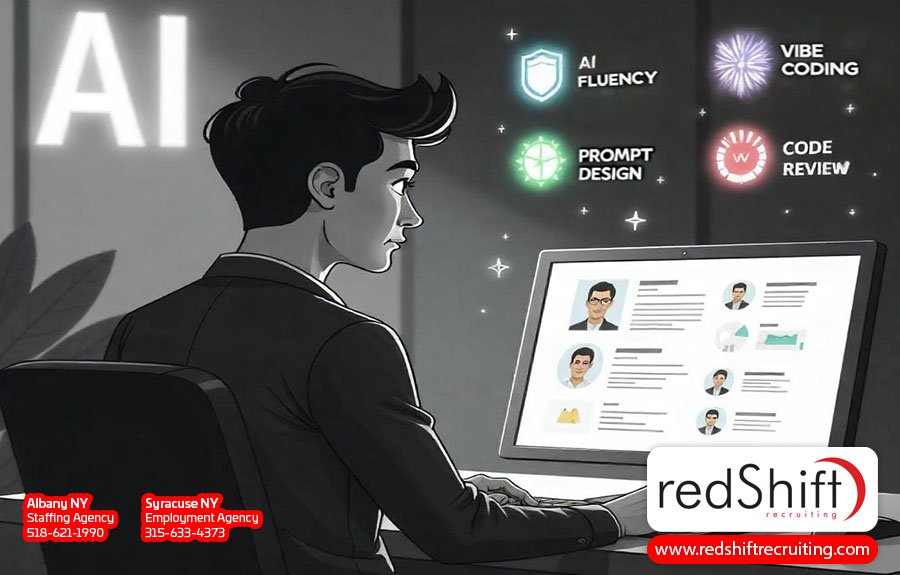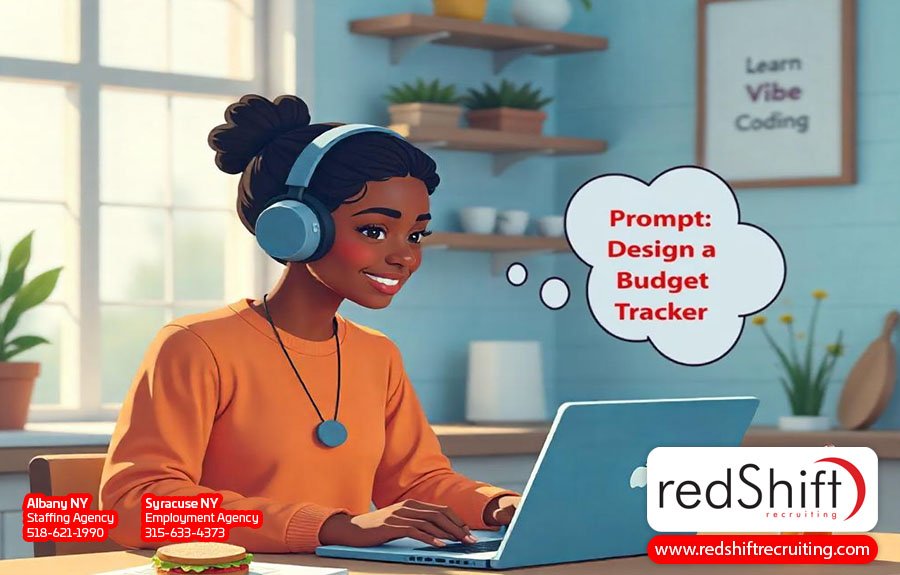What Is Vibe Coding and Why Should Hiring Managers Care?
Once upon a time, you had to know how to code to, well… code. Then came AI coding assistants like GitHub Copilot, ChatGPT, and Claude, and now developers are building apps by talking to machines like they’re ordering coffee. Even someone with zero coding experience can pull up one of these tools and say, “Build me a simple login page,” or “Help me create an app,” and the AI gets to work. No manual coding. No file trees. Just a good prompt and a large language model (LLM) that fills in the blanks.
This is vibe coding in action—and no, it’s not just another trendy tech term. Coined by OpenAI co-founder Andrej Karpathy in early 2025, vibe coding describes a new way of working with AI where developers (and sometimes non-developers) describe what they want, and the AI generates the code. While the term is new, AI-assisted code generation has been steadily advancing since the release of early tools like GitHub Copilot in 2021 and ChatGPT in 2022. It has the potential to change how software is created—and with it, the role of the developer.
If you’re hiring for technical roles, understanding how these tools are reshaping developer workflows is essential—not just to evaluate candidates, but to know what skills truly matter. Can someone who vibe codes do the job of a developer? What exactly does that look like in practice? This article breaks down what vibe coding is, how it works, and what recruiters and hiring managers need to know.
What Is Vibe Coding?
So, exactly what is vibe coding? It’s a term coined by Andrej Karpathy in early 2025 to describe a style of software development where, instead of manually programming every line, users describe what they want in plain language and the AI builds it for them. This shifts the focus from how the code is made to the intent behind it and the desired outcome, allowing users to focus on what they want to build instead of how to write the code to build it, and opening software creation to non-developers with limited or even no coding experience. The “vibe” refers to the general feel or intent of the software—what it should do, look like, or behave like—rather than a precise technical specification. It’s part development, part delegation, and it’s changing the nature of what it means to write code.
How Do Vibe Coding Tools Work?
As AI tools become more capable, developers and hobbyists alike are shifting from manual coding to AI-assisted coding. Instead of painstakingly writing code line by line, the user gives instructions to AI coding tools like ChatGPT, GitHub Copilot, Claude, Cursor Composer, or Gemini. These instructions are delivered in plain, natural language, such as “create a login form with email validation” or “build a dark mode toggle for mobile.”
Powered by large language models (LLMs) and trained on vast public codebases, the AI tools interpret the user’s request and translate it into working code. The result might be a small function, a new feature, or an entire basic app. The human reviews what’s generated, runs it, and gives feedback like “make it responsive” or “change the font to Roboto.” The AI then revises the output. The process of generating, testing, and refining repeats until the user is satisfied.
This is AI code generation in action. And when it works well, it feels less like programming and more like co-piloting. You're guiding the outcome, not manually building it from scratch.
How Does Vibe Coding Differ From Traditional Coding?
What makes vibe coding different isn’t just the use of AI; it’s the entire relationship to the code itself. Rather than focusing on technical precision, the user focuses on getting something that works. You may never interact with the code structure directly or even look at every line. As Karpathy put it, “There’s a new kind of coding I call vibe coding… where you fully give in to the vibes, embrace exponentials, and forget that the code even exists.”
Instead of writing every button, class, and layout by hand, the user relies on AI code generation to scaffold features, adjust boilerplate code, and generate changes. For beginners, it opens up the ability to build software for simple tasks like internal tools or personal projects by typing a prompt into an AI tool, copying the result, and pasting it into their project. For experienced developers, it becomes a workflow: prompting the AI to generate code, then editing, reviewing, and refining the results until the solution is sound. Again, Karpathy describes it as, "I'm building a project or webapp, but it's not really coding - I just see stuff, say stuff, run stuff, and copy paste stuff, and it mostly works."
That "mostly works" is an important consideration, however. While AI-assisted coding sounds fast and efficient (and often is), the output can be inconsistent. In some cases, you'll have clean, functional code written in minutes; in others, you might end up debugging an unstable code extension that conflicts with the rest of the system. Without a skilled human checking the AI’s work and fixing bugs, the risk of breakage or bloat is significant. This is especially true when using tools in agent mode, which can trigger multi-step actions without the user explicitly reviewing each one, leading to compounding errors as the code grows if left unchecked.
These risks are acceptable for low-stakes projects, demos, or experimenting with wild new ideas. But if you're building something intended to scale, or anything that demands consistent quality, security, or longevity, you'll need proper testing and an experienced developer who knows what they're looking at.
Is Vibe Coding the Same as Low-Code/No-Code?
The term vibe coding is sometimes lumped in with low-code or no-code platforms, but they solve different problems and operate differently. Low-code/no-code platforms use graphical user interfaces (GUI) and templates to let you essentially drag, drop, and build applications without needing to write much (or any) code. Think of popular website builders like Squarespace or Wix, or more advanced platforms like Bubble that let users create full web applications. They’re great for building internal dashboards, quick prototypes, or simple apps because they’re easy to use and handle most of the technical setup for you behind the scenes. These tools don’t require much technical knowledge, but they’re also limited by their frameworks.
Vibe coding, on the other hand, is prompt-driven. The user works in a text-based (or voice-based) interface or an integrated development environment (IDE) like VS Code or Cursor, and the AI responds by generating real code. It’s flexible and powerful, but also harder to predict. And unlike manual coding, the person using it might not fully understand what’s being generated, which makes quality control all the more essential.
What all this means is that the human still matters. They need to test the results, spot edge cases, and know when to push back. Without that, you may end up with something that appears functional but hides serious flaws. In short, vibe coding can do more than low-code/no-code, but it also demands more: sharper judgment, rigorous testing, and ideally, a solid technical foundation. Whether your candidate has that skillset is exactly what we’ll explore in the next section.
Rethinking the Developer Role
The rise of AI in software development is not only changing how code is written, but also what it means to be a developer. Vibe coding tools aren’t a replacement for experienced developers, but they are reshaping the skills and workflows required to be effective.
What AI-Assisted Developers Actually Do
With AI-assisted development, modern developers don't have to spend their days typing out every line of code. Instead, they define their goal, give the AI clear instructions, review its output, and integrate the results into the broader system. They can use AI tools to automate repetitive tasks, rapidly test ideas, and prototype new components in hours instead of days. The key is knowing when to step in with human judgment and question what the AI gives them.
As AI takes over more of the hands-on coding, developers are shifting their focus from how to write code to what the code should achieve, emphasizing intent, design, and oversight. This also creates new roles like prompt engineers or AI specialists who can translate vague requirements into precise, actionable prompts that reliably generate usable code.
This shift favors people who can reason through complex problems, troubleshoot issues, and communicate effectively with the AI to generate useful results. For some roles, memorizing syntax or mastering obscure frameworks may not be as important as knowing how to collaborate with tools like Copilot, Claude, or Gemini to produce code that fits the purpose and holds up under scrutiny. You’ll still need skilled human programmers, but what makes someone “skilled” is changing.
New Team Dynamics in AI-Driven Development
As the developer role changes, so do the teams around it. Having AI assistance can boost speed and efficiency, but it also adds new complexity and oversight demands. This often means:
Smaller, more agile teams, with higher expectations for individual performance
Hybrid roles that blend technical skill with product thinking (for example, developers who can shape a feature, prompt the AI to build it, and then test it themselves)
New specialties like AI code auditors, AI system integrators, or AI “orchestrators” who manage workflows across multiple models and tools
More cross-functional collaboration as AI reduces technical barriers and enables broader participation in producing software
Your code base may now be growing faster than ever—but speed means nothing without stability. It's your responsibility to ensure the people behind it can maintain quality and scalability as things accelerate. The bottom line is that hiring in software engineering now requires a new level of nuance. You’re not just hiring someone who can code; you’re hiring someone who can think critically, collaborate with AI when appropriate, and deliver results that are accurate, secure, and scalable.
Vibe Coding’s Impact on Hiring and Recruiting
AI-assisted development is reshaping the hiring market, and staffing professionals are uniquely positioned to help companies adapt. From redefining what makes a great developer to identifying overlooked talent pools, recruiters and hiring managers play a key role in this transition.
Redefining “Developer” for Recruiters
For recruiters and hiring managers, vibe coding is forcing a redefinition of what a “developer” even looks like, both on paper and in practice. Traditional indicators like years of experience, GitHub activity, or lines of code tell you far less than they used to. A relevant portfolio today is often outcome-driven: what did they build, how did they build it, and how well does it work?
That shift poses a challenge: if developers are using AI to code, how do you screen for skills like prompt engineering or the ability to use those tools effectively? How do you differentiate someone who uses an AI coding assistant responsibly from someone who just clicked “Generate” and submitted whatever came out? Should you even hire someone who vibe codes, and how can you tell if they do?
The answer isn’t to avoid vibe coders—it’s to evaluate how skillfully they use the tools. Vibe coding doesn’t mean a lack of competence. In fact, some of the most effective developers today are those who combine technical depth with the ability to guide AI tools toward high-quality results. The key is to look past the buzzword and focus on their thinking, judgment, and process.
Evaluating Developers in the Age of AI
If you’re evaluating candidates who use AI to code, it’s not enough to check their GitHub or glance at a polished UI. You need to assess whether they understand what the AI is doing, and whether they know how to guide and correct it.
Here’s what to prioritize:
Prompt Engineering: Can they write and iterate on prompts effectively? Understand the difference between being prompt literate (which means they can use AI tools at a basic level) and being a prompt engineer, who has mastered the nuances of prompt design for consistent, high-quality output.
System Design & Architecture: Do they see the big picture? Can they design scalable systems, not just piece together features?
Debugging & Verification: AI is helpful, but far from infallible. Can they catch subtle bugs or incorrect logic and fix it?
Testing & QA: Can they test for performance, edge cases, and security vulnerabilities, not just surface-level functionality?
Problem-Solving & Critical Thinking: Can they break down complex requirements and explain them clearly to both AI and humans?
Domain Expertise: Do they understand your product, users, or industry? A developer with a deep understanding of your business context will guide AI more effectively and validate the output with better judgment.
Ethical AI & IP Awareness: Do they understand how using AI tools affects intellectual property? Can they recognize when AI-generated code might introduce licensing conflicts, privacy risks, or biased logic?
Adaptability: AI tools are changing fast. Are they staying current, experimenting with new approaches, and comfortable learning as they go?
Collaboration: AI doesn’t eliminate the need for clear communication. Can they work well with designers, PMs, and other developers?
Finally, be cautious of the false impression that someone is highly qualified just because their output looks clean. With AI in the mix, it’s easier than ever to present impressive work without truly understanding what’s behind it. If a portfolio is full of polished UI screenshots but the candidate struggles to explain how it was built or tested, that’s a red flag. Take time to ask questions and dig into how they got there—not just what they built, but how they built it.
Strategic Opportunities for Staffing Agencies
The impact of vibe coding isn’t limited to individual hires either. It’s transforming how teams are built, which opens new opportunities—and responsibilities—for the staffing industry as a whole. As we enter this new territory, recruiters and staffing agencies have a critical role in bridging the gap between outdated hiring expectations and modern realities. Those who stay ahead of the curve can offer not just talent but strategic insight into how AI is reshaping software teams.
Specialized talent sourcing: Recruiters who understand AI-assisted workflows can source candidates skilled in software creation through collaboration, not just code mastery. That’s a differentiator.
Candidate assessment support: Helping clients and managers assess practical skills like how a candidate prompts, explains, and iterates adds value. Ask questions like, “How did you approach building this feature with AI?” or “What went wrong, and how did you fix it?”
Training and upskilling programs: Partner with clients, supervisors, or learning providers to help junior developers grow into AI-capable contributors or retrain mid-level developers to stay competitive.
Additionally, some clients may assume AI replaces junior roles, but what they really need are junior developers trained to work with AI.
Workflow consulting: AI doesn’t just change roles—it changes how work gets done. Staffing firms can advise on team design, the right mix of AI-fluent roles, and when to use AI for quick prototyping versus when to bring in deeper technical expertise.
Access to niche talent: Early adopters of these tools often aren't found through traditional channels. They may be indie builders, open-source contributors, or career switchers who’ve mastered the tools but don’t look “typical” on paper.
Thought leadership: Professional recruiters can become a trusted voice in helping clients understand where this trend is headed and how to make smart hiring decisions as AI evolves.
For staffing professionals willing to learn the landscape, vibe coding isn’t a threat—it’s an opportunity to lead the next era of technical hiring.
Preparing for the Vibe Coding Future
The term vibe coding may sound informal, but the shift it represents is very real—and accelerating. As more developers lean on AI models to build everything from dashboards to full-scale web apps, recruiters need to adapt quickly. That starts with staying informed about advances in artificial intelligence and how they’re reshaping technical roles. Job descriptions should reflect new skills like prompt literacy, AI fluency, and validation capabilities. Interview strategies should adjust too, incorporating scenario-based prompts and asking candidates to explain or debug AI-generated code to reveal how well they understand the logic, context, and limitations of what the AI produces.
Looking ahead, there will likely be new norms around code quality, auditability, and the ethical use of AI in development. Tools will change. Prompts will evolve. And the hiring market will continue to shift. But recruiters and staffing professionals who embrace this shift early will not only find better talent—they’ll become trusted advisors in building the next generation of software teams.
Frequently Asked Questions
Can Someone Who Uses AI to Code Be Considered a Developer?
Yes—if they know how to use AI responsibly and effectively, they can absolutely be considered a developer. While traditional coding often meant line-by-line programming, today’s software engineering roles can also involve working alongside AI models that assist in generating and refining code. The key distinction is whether the person understands what the AI is doing, can spot errors, and knows how to apply the output meaningfully. Using tools like ChatGPT or GitHub Copilot doesn't make someone less of a developer; it just means they're leveraging modern tools to enhance productivity.
What Skills Should I Look for in a Vibe Coder?
Look for candidates who can define technical goals clearly, prompt AI tools effectively, and evaluate the results. Core skills include problem-solving, system thinking, debugging, and prompt literacy. A strong candidate won’t just rely on the AI; they’ll know how to guide it and when to step in. They should be able to explain how they handled edge cases, responded to error messages, and validated the functionality of the code. Reviewing a few real-world vibe coding examples—and hearing how they managed the process—can help you spot real capability.
How Do You Assess a Candidate Who Uses Vibe Coding?
Assessment should focus on the thinking behind the code—not just the final product. Ask candidates to walk you through a feature they built using an AI tool: what prompts did they use, what challenges did they face, how did they iterate, and what decisions did they make themselves? You can also use scenario-based prompts or ask them to review and improve a block of AI-generated code. What matters most is whether they can critically evaluate what the AI provides rather than just accepting the output at face value.
Are There Legal or IP Issues With AI-Generated Code?
Yes, there can be. Depending on the tool used and how it was trained, there may be questions around copyright, open-source licensing, or attribution. Some AI models may generate code snippets that resemble existing open-source libraries without proper citation. It's important for candidates (and hiring teams) to understand the licensing implications of using AI-generated code in commercial projects and to have a process in place for reviewing and vetting that code before deploying it.
Should I Include Vibe Coding Skills in My Job Descriptions?
If you're hiring for roles that involve rapid iteration, prototyping, or integration with AI tooling, then yes, mentioning familiarity with AI coding tools or prompt-based workflows can help attract the right candidates. That said, don't treat vibe coding as a standalone skill. Instead, frame it as part of a broader competency set that includes testing, debugging, and architectural understanding. The ability to co-create with AI is valuable, but it's even more powerful when paired with strong foundational knowledge and the ability to work with others to develop real solutions.
Conclusion
Vibe coding is changing how software is built, shifting the focus from manual execution to guiding AI toward a desired outcome. It doesn’t eliminate the need for skilled developers, but it does change what those skills look like.
For recruiters and hiring managers, this requires a change in how you evaluate and source tech talent. In some cases, this may mean less focus on finding someone who can write every line of code themselves, and more emphasis on identifying those who can think critically, communicate clearly, and collaborate effectively with the tools now shaping how work gets done. Staying ahead means adapting your hiring strategy—not just to the tools, but to the human judgment that makes those tools effective.
Article Author:
Ashley Meyer
Digital Marketing Strategist
Albany, NY







